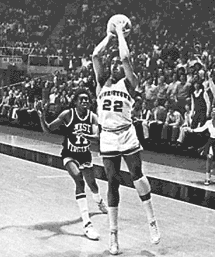Post by DanMcQ on Jun 25, 2013 9:28:28 GMT -5
www.boston.com/sports/colleges/2013/06/24/ncaa-expands-replay-use-college-basketball/OhcWDnf15XN4cloSTvSn4L/story.html
The Playing Rules Oversight Panel also approved a tweak to the charging-blocking foul in the men’s game and gave referees leeway when it comes to penalties for accidentally elbowing an opponent above the shoulders.
The approved changes from the panel’s conference call are effective immediately.
Under the replay change, officials can use video review to confirm a shot-clock violation or determine who caused the ball to go out of bounds on a deflection involving two or more players in the final two minutes of regulation or overtime.
Changes also were made for reviewing 3-pointers. For the first 36 minutes of play, officials must wait until the next media timeout to review whether a shot was a 3-point field goal. In the last four minutes of the game and the entire overtime, officials will go to the monitor immediately to determine whether a field goal was a 3.
Officials also can use the monitor to determine which player committed a foul. Previously, they were only allowed to use the monitor to determine the free-throw shooter.
The defender is no longer able to slide into the offensive player’s path to the basket at the last moment and draw a charge. The defender has to be in position when the player on offense starts his upward motion with the ball. In addition, greater emphasis is being placed on calling fouls on defensive players who keep a hand or forearm on an opponent or use an arm bar to impede the progress of an opponent.
When it comes to an elbow above the shoulders, referees will be allowed to use a video monitor to determine the severity of the blow. If deemed inadvertent, the referee could call a player-control foul or even nothing.
The approved changes from the panel’s conference call are effective immediately.
Under the replay change, officials can use video review to confirm a shot-clock violation or determine who caused the ball to go out of bounds on a deflection involving two or more players in the final two minutes of regulation or overtime.
Changes also were made for reviewing 3-pointers. For the first 36 minutes of play, officials must wait until the next media timeout to review whether a shot was a 3-point field goal. In the last four minutes of the game and the entire overtime, officials will go to the monitor immediately to determine whether a field goal was a 3.
Officials also can use the monitor to determine which player committed a foul. Previously, they were only allowed to use the monitor to determine the free-throw shooter.
The defender is no longer able to slide into the offensive player’s path to the basket at the last moment and draw a charge. The defender has to be in position when the player on offense starts his upward motion with the ball. In addition, greater emphasis is being placed on calling fouls on defensive players who keep a hand or forearm on an opponent or use an arm bar to impede the progress of an opponent.
When it comes to an elbow above the shoulders, referees will be allowed to use a video monitor to determine the severity of the blow. If deemed inadvertent, the referee could call a player-control foul or even nothing.


